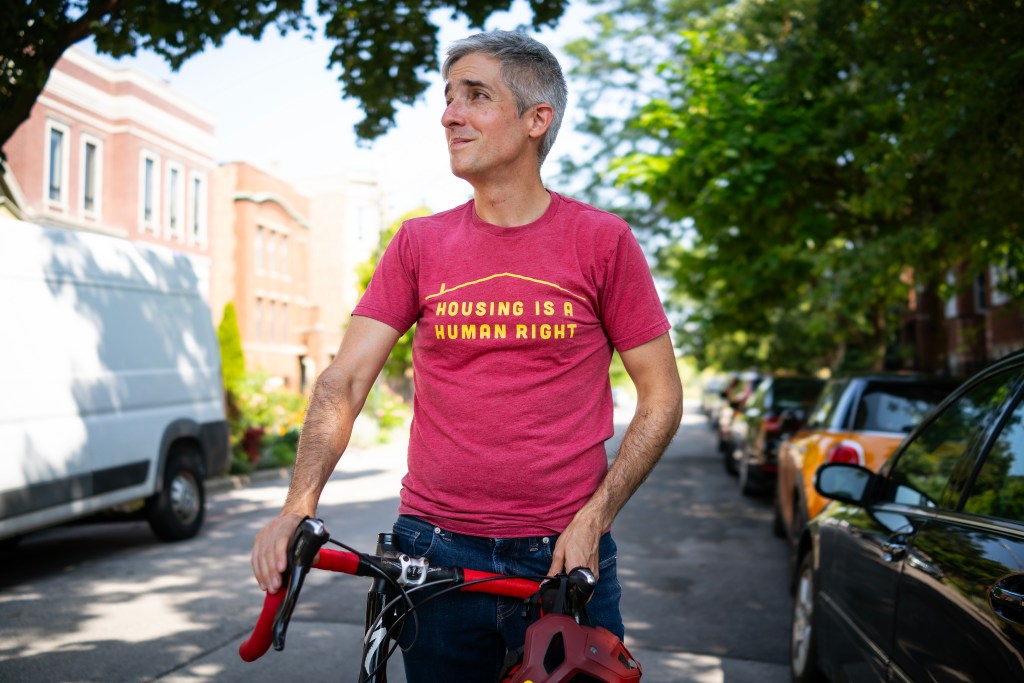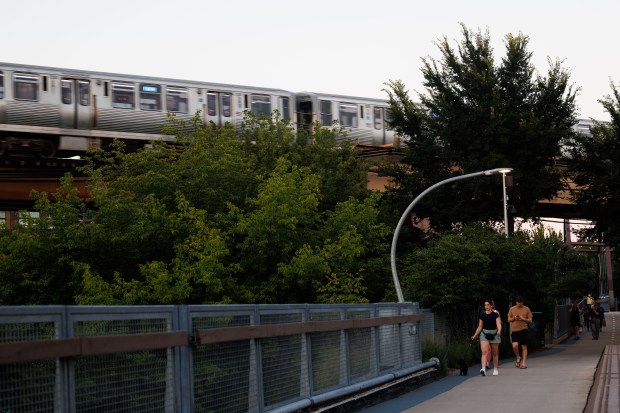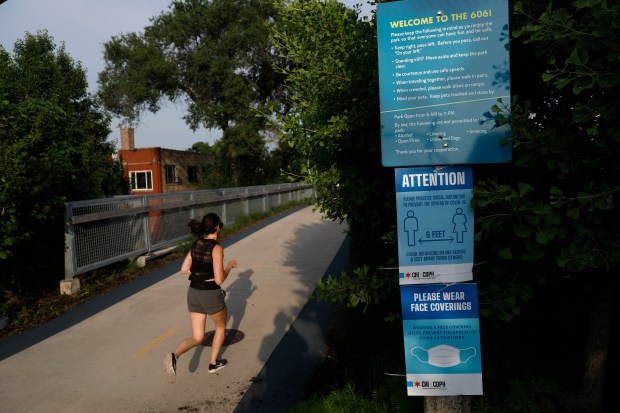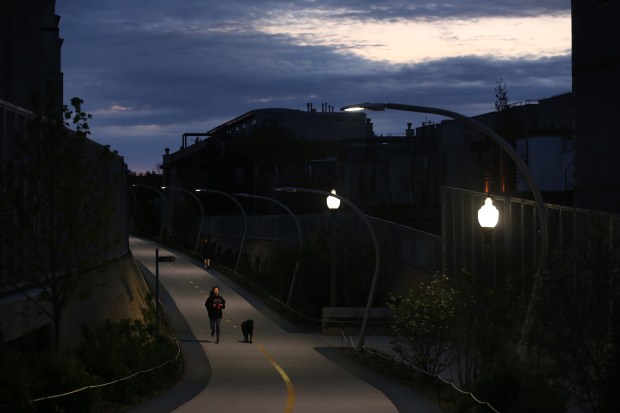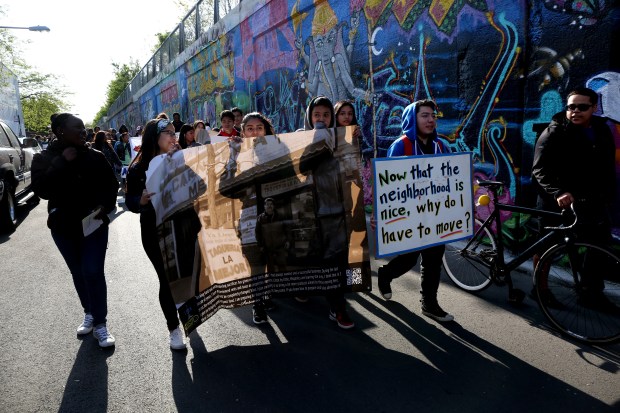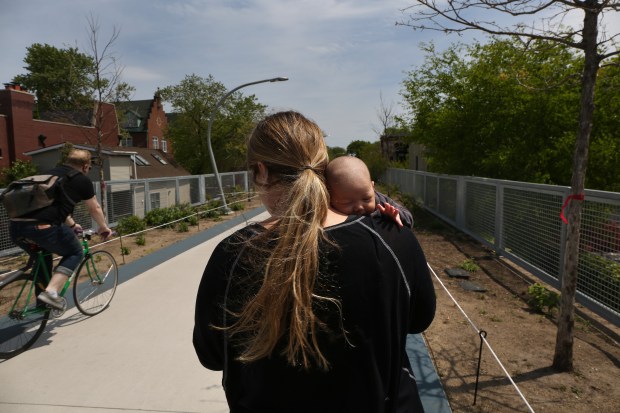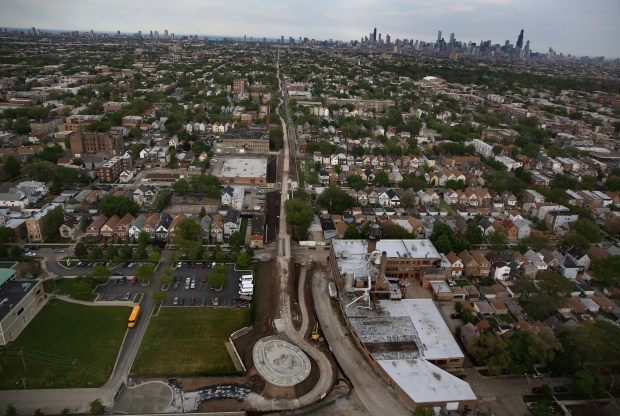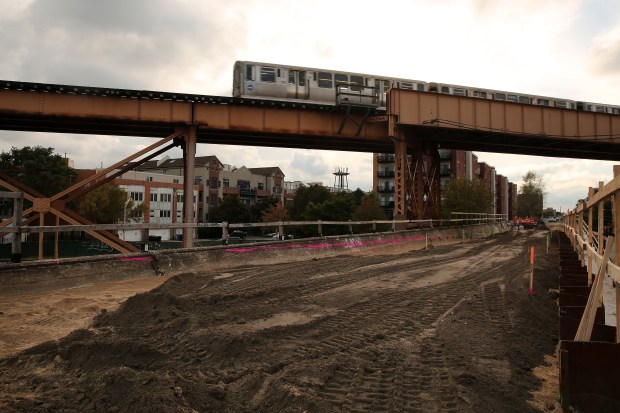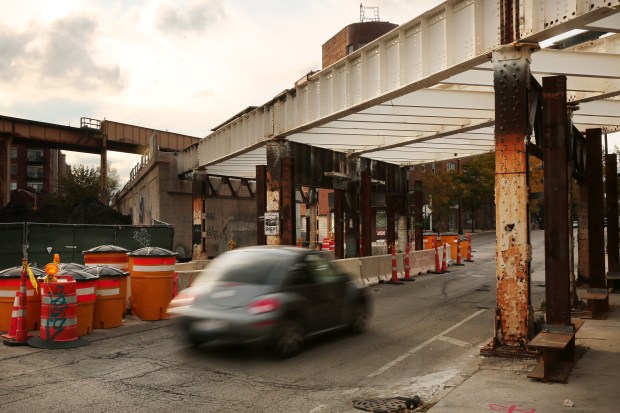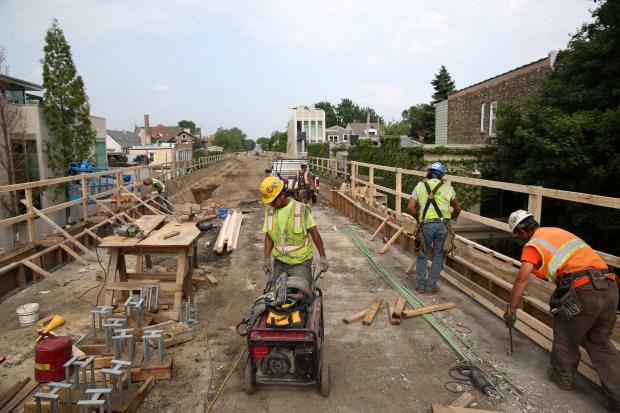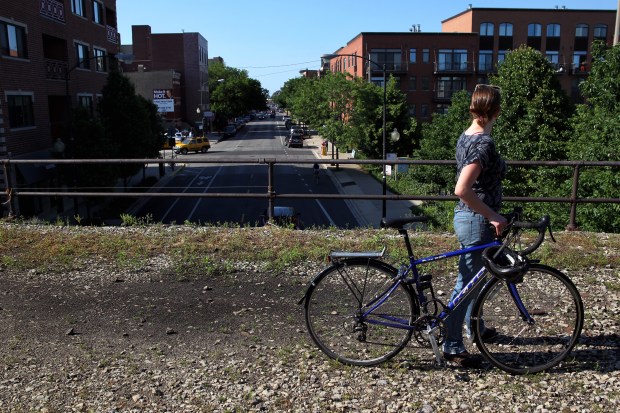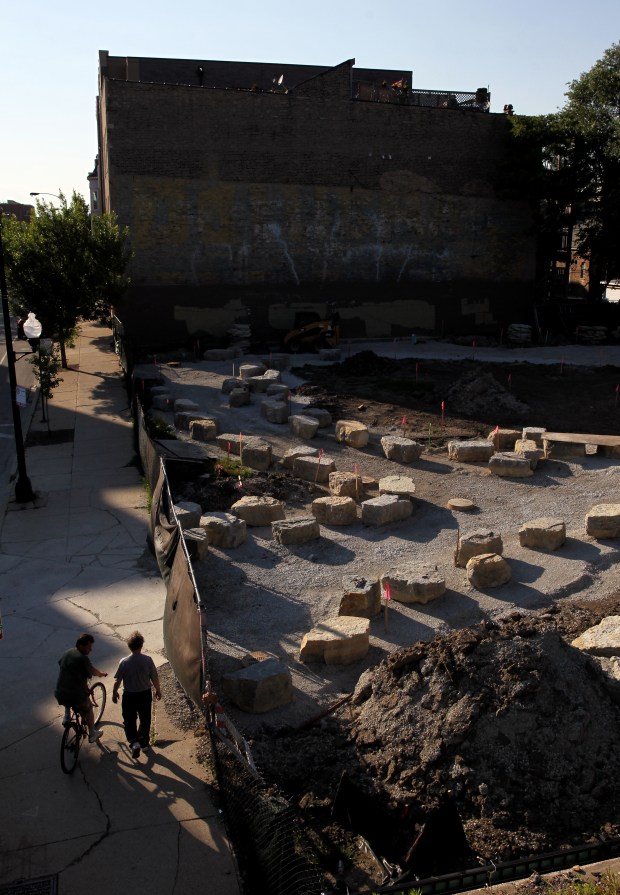When David Amato walks into eviction court Thursday, he’ll have a lot on his mind.
Anger at the new landlord who he says plans to double rent after booting him and refused to negotiate after purchasing the Logan Square building where he lives. Pride in the six-month rent strike he and his tenants union are waging in response.
And bitterness that a tool he believes would have given him and his neighbors the power to outmuscle a rich corporation to instead buy the 16-unit building themselves — and stay in their homes — materialized just months too late.
“These people are just steamrolling this area. They’re buying up buildings left and right, they’re throwing people out of their houses and it’s just devastating people,” Amato said. “You don’t have to be a genius to buy a building. I think we could have.”
But the program progressive aldermen put in place this year to give longtime residents like Amato the power to try to keep their homes in the vicinity of the popular 606 trail and other parts of fast-gentrifying Northwest Side neighborhoods is now suffering rollbacks.
While the Northwest Side Preservation Ordinance aims to slow gentrification by giving tenants a “right of first refusal” and discouraging development that decreases density, a pair of aldermen are opting out. They say the still-nascent law that affects neighborhoods including Avondale, Humboldt Park and Logan Square severely disrupts real estate deals and strips homeowners of the right to control their property.
At stake is a policy that advocates hope will serve as a citywide blueprint for creating and preserving more affordable housing and more renter power, the latest battlefront in a decades-long fight over the future of residential development in the area. But it may also be an example of how complicated maintaining and boosting housing affordability is as Mayor Brandon Johnson and other elected officials zero in on rising rents and home prices as a marquee issue.
Last month, Aldermen Felix Cardona, 31st, and Gilbert Villegas, 36th, removed their wards from the pilot ordinance that is in effect through 2029, shrinking the covered area by around 10%.
They argue the policy muddles the title insurance process, hinders loans and undercuts tax benefits. Altogether, they believe, the measure severely disrupts real estate transactions and strips homeowners of the right to control their properties.
Cardona blasted the ordinance last month to City Council colleagues. He told them it falls short by failing to include the educational outreach and financial support needed to truly facilitate renter purchases. Most of the homes in the small part of his ward formerly touched by the ordinance are already owner-occupied, he said.
Show Caption
1 of 44
A residential building sits above The 606 trail in Chicago on Aug. 14, 2025. (Armando L. Sanchez/Chicago Tribune)
“These are not corporate landlords. They are longtime residents and homeowners who have invested in their communities for generations. This ordinance, while well intended, puts an undue burden on those homeowners,” he said.
The right of first refusal was implemented in March after delays. So far, it does not appear to have been used by any renter in the pilot area to purchase a home, though proponents argue it is far too early to judge the measure and plan more outreach efforts to make tenants aware of their new rights and financing support.
A similar “right of first refusal” ordinance affecting the Woodlawn neighborhood passed by the City Council in 2020 has also never been used by a tenant to purchase a home, according to the Department of Housing.
Even with the nonuse, the ordinance is still a “commercially unreasonable and unworkable” gauntlet, attorney Jacob Meister said. He experienced its complications first hand as he tried to help a Humboldt Park school teacher sell her home of 25 years, he said.
The woman, who asked to remain anonymous, had tried to comply with the law. Her two tenants did not want the property and signed waivers to pass up a purchase. But the city at first only confirmed that the building owner had complied with the ordinance in an insufficiently official email, Meister said.
It didn’t satisfy Meister and the title insurance company, which feared that a lack of assured compliance could lead to legal liability and title challenges in the future, he said. The owner had already made plans to move to Florida and retire once the deal went through, but she couldn’t close without clearer confirmation.
“The moving trucks came, and we were waiting on the city,” Meister said. “Waiting, waiting, waiting, waiting.”
The sale ultimately went through earlier this month when Meister got signed affidavits acknowledging compliance with the rule from the tenants. Meister also received what he believes is the first official “certificate of compliance” issued by the city, though he felt that too was not definite enough. He estimated the deal took 20 times the usual amount of work.
“And even then, you can’t even give your client clarity. It’s more like, well, I’ve done my best, but I can’t promise you that you’ve really sold it and can walk away. It could come bite you down the road,” he said.
Meister added that he even supports the goal of the ordinance, giving tenants the opportunity to purchase. But the city must issue “a clear-throated, unambiguous certification,” he said. Otherwise, “you’re messing with people’s homes and their life’s savings.”
Olga Santos, the seller’s real estate agent, said she decided to stop selling homes affected by the ordinance after the complicated transaction.
“I don’t even want to deal with any more properties in this area until they know what they’re doing,” she said.
In a statement, Department of Housing Commissioner Lissette Castañeda said her office recognizes “that new policies can come with challenges” and welcomes “constructive feedback” as it works to balance “community preservation, housing affordability, and responsible development.” Asked about the title issue, Castañeda said the criticism “remains unproven,” adding the department has met with insurers and believes the policy doesn’t create “undue legal liability.”
Two tenant groups have exercised the right of first refusal, showing interest in purchasing homes, she said.
“These early examples demonstrate real potential: property owners are able to sell at fair market value, while long-time tenants—people who know and care about their community—have a chance to remain in place and build equity,” Castañeda said.
But Villegas is not convinced the issues he sees in the ordinance are being resolved. He blamed the problems on “premature” implementation and a failure to include realtors and other business interests in drafting.
He also argued the policy has a more fundamental problem as it restricts how homeowners can operate: Long-term owners, when they want to sell, “have the right to sell that property,” he said.
“You’re putting more burden on homeowners, on their private property,” he said. “All I see here is advocacy organizations, now that they’re in charge, putting forward policies, but not incorporating everybody at the table.”
The ordinance was in part crafted by the Northwest Side’s Palenque Liberating Spaces Through Neighborhood Action. Proceeds from the demolition surcharges — originally enacted in a smaller area in 2021, but this year made four times more expensive at $20,000 per unit and a $60,000 building maximum — now go to the Chicago Housing Trust, a nonprofit staffed by city officials that uses subsidies to preserve affordability.
Jeannette Hernandez, a lifetime Logan Square resident, has fought alongside the group. She lives just outside the part of Cardona’s ward that was removed from the ordinance and had hoped it would soon expand her way, though she has also lived in the still-affected area.
Hernandez sees a story in each building in her neighborhood. She went to elementary school at the red-bricked Jonathan Y. Scammon. She prayed at St. Sylvester Catholic Church. She even sold tennis shoes at the Discount Megamall.
The latter is gone now, demolished and replaced by a Target and an apartment building where a 660-square-foot, one-bedroom unit rents for $2,451 a month. It’s a reminder that she and people she loves might also be removed someday, as many priced out before her have been, she said.
“Everything in the neighborhood is part of my identity, and I’m seeing my identity, the fabric of who I am, being slowly eroded and taken away from me,” Hernandez said. “We can’t stop gentrification, but we can definitely do things that are going to slow it down.”
The criticism of the ordinance has largely come from “special interest” real estate groups, not everyday homeowners, Palenque housing organizer Traolach O’Sullivan said. O’Sullivan said the city is working to resolve the title issues, while advocacy groups are ramping up their outreach efforts and better connect renters with the capital they would need to make a purchase.
“We realized implementation takes a lot of different parts,” he said. “These are things that are being blown up as to why this policy could never work, instead of having an honest conversation.”
The political arm of the Neighborhood Building Owner’s Alliance, a key group opposed to the measure, contributed $1,500 to Cardona’s campaign and $6,500 to Villegas’ in recent years, according to state records.
To use the right of first refusal, tenants in larger properties have three months to start negotiations, then another four months after giving notice to conduct due diligence and secure financing. Renters in smaller properties have one month to give notice, then an additional two months.
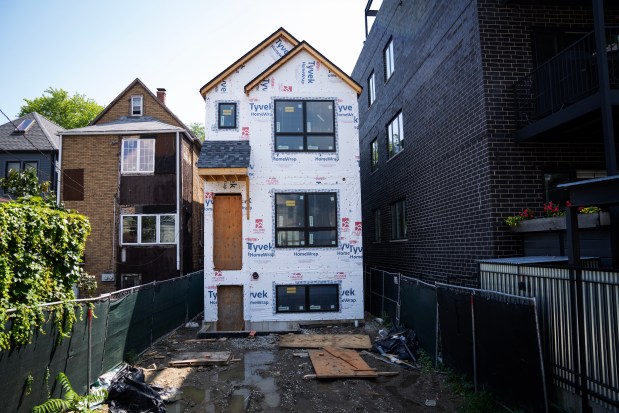 A new two-flat under construction in the Humboldt Park neighborhood on Aug. 13, 2025. (E. Jason Wambsgans/Chicago Tribune)
A new two-flat under construction in the Humboldt Park neighborhood on Aug. 13, 2025. (E. Jason Wambsgans/Chicago Tribune)
For Arya Woody, who tried to use the right of first refusal with neighbors to purchase a Humboldt Park three-flat in March, the task of quickly coming up with the $1,082,000 asking price proved too difficult.
Woody, 25, had lived in the home for three years and grown close with neighbors. A group wanted to stay. They met with the city, got advice from Palenque and researched in hopes of finding enough grant money to supplement their incomes and cover a mortgage.
But a critical grant pool had already been distributed for the year, and an annual property tax bill near $25,000 was daunting. Ultimately, the tenants decided to give up on buying the home. They have only been granted a partial lease renewal from their new landlord.
“I feel like the bones of this ordinance, what they are trying to do, is very useful … but at least in our experience, it was really just down to the money,” Woody said. “I definitely appreciate the attempt to give tenants some sort of agency.”
Amato, however, shared confidence that his tenant union would have been able to find a way to purchase their building at the $3.5 million sale price if they had the chance.
“There are ways. There are certain banks that are willing to work with tenant groups. There are ways to secure financing to have been able to make it happen,” he said.
And even if the group could not figure out how to buy the home themselves, they could have used the ordinance to give their right of first refusal to another, friendlier purchaser, one who would have allowed them to stay on better terms.
“There’s people who would have afforded to do it. I think that person is out there,” he said.
But Jeff Weinberg, an NBOA board member and president of Drexel Properties, said the ordinance’s goal of getting tenants, often strangers, to come together and buy a home is impractical.
“It’s just completely unrealistic,” he said. “It just doesn’t work.”
Meanwhile, he argues the ordinance has had a number of unexpected side effects that have harmed building owners and renters alike.
He felt he had to raise rent on some long-term tenants because the ordinance will compel him to share rent rolls with all of a building’s residents when he eventually sells, he said. The ordinance’s timeline has also effectively taken the “1031 exchange” that allows sellers to defer taxes on capital gains while buying a home “off the table,” pushing many buyers out of the market, he added.
“There are people who want to sell their buildings, and all of a sudden they can’t sell them, or the value that they’re selling them at is far below what they’re worth,” Weinberg said.
The policy was created with no input from landlords, he said.
“When you don’t talk to housing providers, you get bad housing policy,” Weinberg said.
O’Sullivan said NBOA representatives and realtors participated in discussions that led to changes in the ordinance after it passed, and added that Cardona and Villegas have been unwilling to discuss their decision to exit the ordinance.
Ald. Daniel La Spata, 1st, acknowledged that the refusal right might slow down the home-buying process by adding regulation. But hundreds of purchases have still gone through in the area since, he added.
“The notion that it has severely depressed the housing market here is not a truthful narrative,” he said.
He expects the tenant purchasing powers to become stronger as the pilot program matures.
“I think it comes down to education and capital,” La Spata said. “How do we help more tenants understand how to use this ordinance, what their rights are related to it, and how do we work with community development finance institutions to create the right lending products for these tenants.”
But as he rode his black bike through his ward’s many quiet residential streets, La Spata was even more excited about the other components of the policy: the demolition surcharges, the ability for developers to build two-flat homes by right and another aspect aimed at maintaining density.
He worries the aldermen removing their wards from the ordinance are missing the importance of those pieces. “At the end of the day, they have taken a lot of property rights away from their residents,” he said.
The demolition surcharge provides gap funding for “permanently affordable home ownership” and has led to a “substantial decrease” in tear-downs and deconversions, La Spata said. Instead, more building owners are rehabilitating buildings and weighing zoning changes to add units, he said.
The ordinance also preserves density block-by-block, requiring developers to stick with mutlifamily housing on residential streets where the majority of buildings already include multifamily housing.
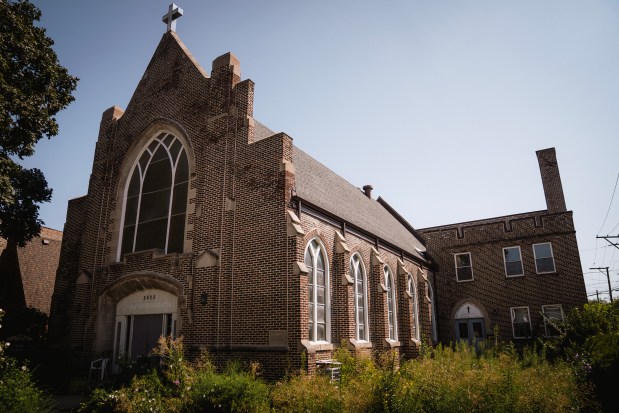 A 100-year-old church that is planned to be repurposed as apartments in the Logan Square neighborhood. (E. Jason Wambsgans/Chicago Tribune)
A 100-year-old church that is planned to be repurposed as apartments in the Logan Square neighborhood. (E. Jason Wambsgans/Chicago Tribune)
La Spata explained that “predominance of the block” rule outside the shuttered Bethel International Full Gospel Church. Developers had wanted to demolish and build three single-family homes at the site but were not allowed to, he said.
“That essentially is what compelled creativity,” he said.
Now, the building’s owner plans to renovate the church so that it includes 16 different housing units for a total of 24 bedrooms. In a neighborhood where many multifamily homes have been torn down or “deconverted” into single-family homes, that’s far more housing than what otherwise would have been built, La Spata said.
“The fact that it is already guiding development in this area, it is more in line with what we want to see for the neighborhood and for the city, that to me is a very real-world success,” he said.
